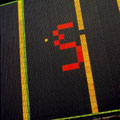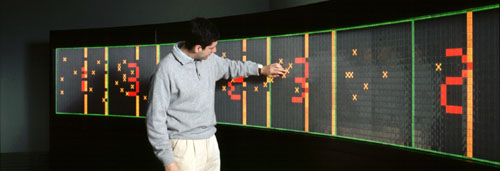







|
|

|
Counter
In this first experiment, the BioWall is a bio-inspired timer. The visitor is
invited to "kill" one or more molecules on the surface by simply
pressing down with his finger. The BioWall, just like
any living being, reacts in order to survive, replacing the dead molecules with healthy neighbors.
|
Counter : Between life and death, the miracle of self-replication
|
Life is regeneration. When the wind knocks off the branch of a tree, it starts growing again from a humble bud. If
you accidentally tread on a flower, it straightens up and regains its splendour in the meadow. Of all the tools invented by mankind,
the BioWall electronic tissue is the first to be directly inspired by the embryonic development of living beings: it grows from a
microscopic piece of information (an artificial genome), repairs itself if it has an accident and can even create a copy of itself
through a self-replication mechanism.
Conception, growth, maturity, injury and scar formation, illness and recovery, aging and death make up the natural cycle of living
beings. This experiment illustrates the corresponding cycle of an artificial organism - a counter. The visitor is confronted with an
inanimate wall, made up of opaque, dark molecules. Then the process is triggered (equivalent to the moment of conception) and the wall
surface is invaded by complex light signals, programming the molecules (we are now in the growth phase) in order to construct a fully
functional electronic counter (this is the maturity stage). The visitor is then invited to cause the organism to develop a fault. Any
pressure he puts on any molecule injures it. The machine reacts and tries to repair itself, forming a scar. Its vital function,
counting, is not affected. When the number of attacks passes a critical threshold, the counter dies and the wall shuts down, the
premise for a new cycle to begin.
|
|
Directions for use
The counter only counts seconds, from 00 to 59 (figure 1). From left to right, the display shows tens of seconds (from 0
to 5), units of seconds (0 to 9) and a spare zone which remains inactive. The counter can be described as being divided into four
cells: two active (indicating tens and units respectively) and two spare.

Figure 1: The counter, made up of four cells,
displays 59 seconds.
|
Zoom on the cell
Each cell is a mosaic of 20x25 = 500 molecules. Each one contains two yellow repair columns (total of 2x25 = 50 molecules)
- see figure 2. Each molecule includes a display of 8x8 = 64 light diodes.

Figure 2: Each of the four cells of the counter is split
into 20x25 = 500 molecules.
|
Self-repairing molecules
You have control over the life of each molecule. You can kill them simply by pressing them with your finger. A dead
molecule is instantly replaced by the neighbour immediately to its right - and so on, until the nearest yellow repair column (figure 3).
You can attack any line of any cell, as long as you obey the following rule: you can only kill a single molecule per line, between
two yellow repair columns.
However many times you attack, the cell survives, although the figure displayed is distorted. Each cell can therefore tolerate a
maximum of two faults per line (one fault between each pair of yellow columns), ie 2x25 = 50 faults in total.

Figure 3: Self-repairing molecules, with distortion to the figure
displayed (nine); each dead molecule is indicated by a yellow square.
|
Self-repairing cells
You decide to break the above rule and cause several faults on the same line of the same cell, between two repair columns
(figure 4). The molecules can no longer repair themselves and the cell dies. However, it is instantly replaced by a spare cell,
situated immediately to its right. The dead cell switches off and becomes a scar. The counter continues to work without fault: the
BioWall tissue has remembered how much time has passed!

Figure 4: Self-repairing cells: one cell dies
and is replaced by the nearest cell to the right;
each dead molecule is indicated by a yellow square.
|
Death of the counter
When two active cells die, the two spare cells take over. If a third cell dies, the counter also dies and the whole
mechanism shuts down. Unlike living beings, however, the BioWall is automatically resuscitated and reverts to its initial state
(figure 1). A new life cycle can begin.
|
Behind the scenes
Our bio-inspired wall is based on a general principle of life - cell differentiation. Each organism is a collection
of cells, each containing a full copy of the genetic programme, the genome. This structure makes the whole organism extremely
robust, since each cell contains the complete plan and can therefore replace any other defective cell.

For further information
- D. Mange, M. Sipper, A. Stauffer, G. Tempesti. "Toward
Robust Integrated Circuits: The Embryonics Approach",
Proceedings of the IEEE, Vol. 88, No 4, April 2000,
pp. 516-541.
- G. Musser. "Robot, Heal Thyself". In M. Sipper and J.A.
Reggia, "Go Forth and Replicate", Scientific American,
Vol. 265, No 2, August 2001, pp. 26-35.
Resources
 |
E. Petraglio with the BioWall.
© C. Sporer
1,276KB JPEG
|
|
 |
G. Tempesti with the BioWall.
© C. Sporer
1,154KB JPEG
|
|
|
|
 |
The counter on the prototype.
© A. Herzog
73KB JPEG |
|
 |
Killing a molecule in the counter.
© A. Herzog
126KB JPEG |
|
 |
C. Teuscher on the prototype.
© A. Herzog
191KB JPEG |
|
|
 |
Children playing with the BioWall.
© Eurelios
37KB JPEG |
|
 |
C. Teuscher with the BioWall.
© Eurelios
44KB JPEG |
|
 |
The counter
in action (zoom).
© SAVE,
EPFL
1,298KB MPEG |
|
 |
The counter
in action (pan).
© SAVE,
EPFL
2,094KB MPEG |
|
 |
The counter
in action (dark).
© SAVE,
EPFL
2,726KB MPEG |
|
 |
Self-repair on the BioWall.
© SAVE,
EPFL
3,015KB MPEG |
|
 |
Growth
of the counter (right).
© SAVE,
EPFL
7,181KB MPEG |
|
 |
Growth
of the counter(left).
© SAVE,
EPFL
8,119KB MPEG |
|
|
|
|

